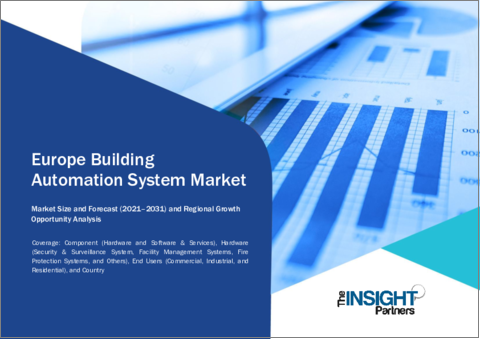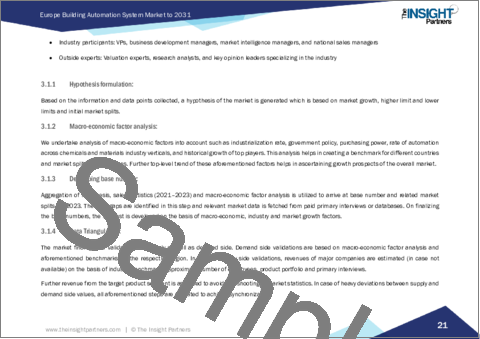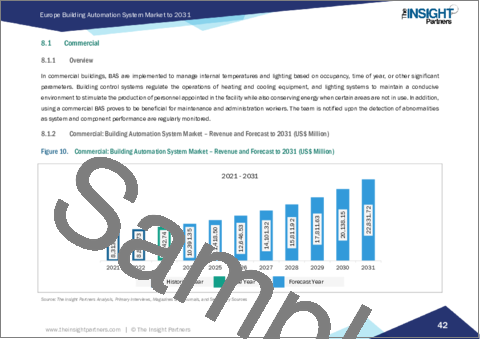|
|
市場調査レポート
商品コード
1666283
欧州のビルディングオートメーションシステム市場:2031年までの予測 - 地域別分析 - コンポーネント別、エンドユーザー別Europe Building Automation System Market Forecast to 2031 - Regional Analysis - by Component and End User (Commercial, Industrial, and Residential) |
||||||
|
|||||||
| 欧州のビルディングオートメーションシステム市場:2031年までの予測 - 地域別分析 - コンポーネント別、エンドユーザー別 |
|
出版日: 2025年01月13日
発行: The Insight Partners
ページ情報: 英文 148 Pages
納期: 即納可能
|
- 全表示
- 概要
- 図表
- 目次
欧州のビルディングオートメーションシステム市場は、2023年に209億8,492万米ドルとなり、2031年までには471億139万米ドルに達すると予測され、2023年から2031年までのCAGRは10.6%と推定されます。
無線センサーネットワーク技術と無線プロトコルのビルディングオートメーションシステムへの統合が欧州のビルディングオートメーションシステム市場を活性化
従来のビルディングオートメーションシステムは、有線インフラに大きく依存していたため、センサーの配置やシステム拡張の柔軟性に限界がありました。この制限を克服するため、無線センサーネットワーク(WSN)技術を搭載したセンサを無線で配置できるようになり、再構成や拡張が容易になりました。無線センサーネットワークは、大規模なケーブル配線の必要性を排除し、設置コストと労力を削減します。WSN技術により、ビルシステムの制御やリアルタイムの監視が可能になり、居住状況や環境条件に基づいてエネルギー使用量を最適化できます。国際エネルギー機関の報告書によると、2022年には、建物の運用(26%)と、建物の建設に使用される材料の生産に関連する体積排出(7%)を含め、建物部門がエネルギーシステム全体の排出量の約3分の1を占めました。
Z-Wave、6LoWPAN、ZigBee、EnOceanなど、多くの無線プロトコルと標準規格が実装されており、無線技術の使用に重点を置き、ビルディングオートメーションシステムのエコシステム内でイノベーションを提供しています。さらに、Z-Waveプロトコルは、シンプルで無線、相互運用可能なRFベースの通信ベースの技術であり、特に軽商用および住宅環境における監視・制御およびステータス読み取りアプリケーション向けに設計されています。このプロトコルにより、企業は顧客に幅広いホームオートメーションオプションを提供することができます。そのため、無線センサーネットワーク技術と無線プロトコルをビルディングオートメーションシステムに統合することが、ビルディングオートメーション市場を牽引しています。
欧州のビルディングオートメーションシステム市場概要
エネルギー効率の向上とCO2排出量削減のため、2025年1月までに第三次産業用建物にビルディングオートメーションコントロール・システム(BACS)を設置することが規制により義務付けられています。2020年、欧州連合(EU)の全加盟国は、EUの建築物エネルギー性能指令(EPBD)に従い、この指令を国内法に組み込む義務を負いました。同指令は、定格出力290kW以上の既存および建設中の非住宅建築物に、ビル管理システムを含む自動制御システムの設置または改修を義務付けています。この要件は、欧州議会・理事会指令2010/31/EUから移管された法律に基づくもので、EPBDからのガイダンスがあります。BACS政令は、エネルギー効率の向上、CO2排出量の削減、非住宅建築部門における持続可能な実践の促進を目的とした重要な規制措置であり、国およびEUの両レベルにおけるより広範な環境およびエネルギー効率の目標に沿ったものです。この規制措置が欧州のビルディングオートメーションシステム市場を後押ししています。
欧州のビルディングオートメーションシステム市場の収益と2031年までの予測(百万米ドル)
欧州のビルディングオートメーションシステム市場セグメンテーション
欧州のビルディングオートメーションシステム市場は、コンポーネント、エンドユーザー、国に分類されます。
コンポーネントに基づいて、欧州のビルディングオートメーションシステム市場は、ハードウェアとソフトウェア・サービスに二分されます。2023年にはハードウェアセグメントがより大きな市場シェアを占めています。さらに、ハードウェアセグメントは、セキュリティ・監視システム、施設管理システム、防火システム、その他にサブセグメント化されます。
エンドユーザー別では、欧州のビルディングオートメーションシステム市場は商業、産業、住宅にセグメント化されます。2023年には、商業セグメントが最大の市場シェアを占めました。
国別では、欧州のビルディングオートメーションシステム市場は、フランス、ドイツ、英国、イタリア、ロシア、その他欧州に区分されます。2023年の欧州のビルディングオートメーションシステム市場シェアはドイツが独占しました。
ABB Ltd、Mitsubishi Electric Corp、Bosch Sicherheitssysteme GmbH、Honeywell international Inc、Schneider Electric SE、Siemens AG、Johnson Controls International Plc、Carrier Global Corp、Lutron Electronics Co., Inc、Trane Technologies Plcは、欧州のビルディングオートメーションシステム市場で事業を展開している主要企業です。
目次
第1章 イントロダクション
第2章 エグゼクティブサマリー
- 主要洞察
- 市場の魅力
第3章 調査手法
- 2次調査
- 1次調査
- 仮説の策定
- マクロ経済要因分析
- 基礎数値の開発
- データの三角測量
- 国レベルのデータ
第4章 欧州のビルディングオートメーションシステム市場情勢
- エコシステム分析
- バリューチェーンのベンダー一覧
第5章 欧州のビルディングオートメーションシステム市場:主要市場力学
- 市場促進要因
- ビル居住者の快適性、安全性、セキュリティ強化に対するニーズの高まり
- 無線センサーネットワーク技術と無線プロトコルのビルディングオートメーションシステムへの統合
- 市場抑制要因
- 熟練した専門家の不足
- 高い設置・導入コスト
- 市場機会
- 持続可能なビルディングオートメーションソリューションへのニーズの高まり
- スマートシティプロジェクトへの取り組みの高まり
- 今後の動向
- コンシューマーIoT、IPベースデバイス、SaaS、その他の技術開発
- 促進要因と抑制要因の影響
第6章 ビルディングオートメーションシステム市場:欧州分析
- ビルディングオートメーションシステム市場収益、2021年~2031年
- ビルディングオートメーションシステム市場予測分析
第7章 欧州のビルディングオートメーションシステム市場分析:コンポーネント別
- ハードウェア
- ソフトウェア・サービス
第8章 欧州のビルディングオートメーションシステム市場分析:エンドユーザー別
- 商業
- 産業
- 住宅
第9章 欧州のビルディングオートメーションシステム市場:国別分析
- 欧州
- フランス
- ドイツ
- 英国
- イタリア
- ロシア連邦
- その他欧州
第10章 競合情勢
- 企業のポジショニングと集中度
- ヒートマップ分析:主要企業別
第11章 業界情勢
- 市場イニシアティブ
- 製品開発
- 合併と買収
第12章 企業プロファイル
- ABB Ltd
- Mitsubishi Electric Corp
- Bosch Sicherheitssysteme GmbH
- Honeywell International Inc
- Schneider Electric SE
- Siemens AG
- Johnson Controls International Plc
- Carrier Global Corp
- Lutron Electronics Co., Inc
- Trane Technologies Plc
第13章 付録
List Of Tables
- Table 1. Europe Building Automation System Market Segmentation
- Table 2. List of Vendors
- Table 3. Building Automation System Market - Revenue and Forecast to 2031 (US$ Million)
- Table 4. Building Automation System Market - Revenue and Forecast to 2031 (US$ Million) - by Component
- Table 5. Building Automation System Market - Revenue and Forecast to 2031 (US$ Million) - by Hardware
- Table 6. Building Automation System Market - Revenue and Forecast to 2031 (US$ Million) - by End Users
- Table 7. Europe: Building Automation System Market - Revenue and Forecast to 2031 (US$ Million) - by Country
- Table 8. France: Building Automation System Market - Revenue and Forecast to 2031 (US$ Million) - by Component
- Table 9. France: Building Automation System Market - Revenue and Forecast to 2031 (US$ Million) - by Hardware
- Table 10. France: Building Automation System Market - Revenue and Forecast to 2031 (US$ Million) - by End Users
- Table 11. Germany: Building Automation System Market - Revenue and Forecast to 2031 (US$ Million) - by Component
- Table 12. Germany: Building Automation System Market - Revenue and Forecast to 2031 (US$ Million) - by Hardware
- Table 13. Germany: Building Automation System Market - Revenue and Forecast to 2031 (US$ Million) - by End Users
- Table 14. United Kingdom: Building Automation System Market - Revenue and Forecast to 2031 (US$ Million) - by Component
- Table 15. United Kingdom: Building Automation System Market - Revenue and Forecast to 2031 (US$ Million) - by Hardware
- Table 16. United Kingdom: Building Automation System Market - Revenue and Forecast to 2031 (US$ Million) - by End Users
- Table 17. Italy: Building Automation System Market - Revenue and Forecast to 2031 (US$ Million) - by Component
- Table 18. Italy: Building Automation System Market - Revenue and Forecast to 2031 (US$ Million) - by Hardware
- Table 19. Italy: Building Automation System Market - Revenue and Forecast to 2031 (US$ Million) - by End Users
- Table 20. Russian Federation: Building Automation System Market - Revenue and Forecast to 2031 (US$ Million) - by Component
- Table 21. Russian Federation: Building Automation System Market - Revenue and Forecast to 2031 (US$ Million) - by Hardware
- Table 22. Russian Federation: Building Automation System Market - Revenue and Forecast to 2031 (US$ Million) - by End Users
- Table 23. Rest of Europe: Building Automation System Market - Revenue and Forecast to 2031 (US$ Million) - by Component
- Table 24. Rest of Europe: Building Automation System Market - Revenue and Forecast to 2031 (US$ Million) - by Hardware
- Table 25. Rest of Europe: Building Automation System Market - Revenue and Forecast to 2031 (US$ Million) - by End Users
- Table 26. Heat Map Analysis by Key Players
- Table 27. List of Abbreviation
List Of Figures
- Figure 1. Europe Building Automation System Market Segmentation, by Country
- Figure 2. Ecosystem Analysis
- Figure 3. Building Automation System Market - Key Market Dynamics
- Figure 4. Impact Analysis of Drivers and Restraints
- Figure 5. Building Automation System Market Revenue (US$ Million), 2021-2031
- Figure 6. Building Automation System Market Share (%) - by Component (2023 and 2031)
- Figure 7. Hardware: Building Automation System Market - Revenue and Forecast to 2031 (US$ Million)
- Figure 8. Software & Services: Building Automation System Market - Revenue and Forecast to 2031 (US$ Million)
- Figure 9. Building Automation System Market Share (%) - by End Users (2023 and 2031)
- Figure 10. Commercial: Building Automation System Market - Revenue and Forecast to 2031 (US$ Million)
- Figure 11. Industrial: Building Automation System Market - Revenue and Forecast to 2031 (US$ Million)
- Figure 12. Residential: Building Automation System Market - Revenue and Forecast to 2031 (US$ Million)
- Figure 13. Europe Building Automation System Market, by Key Countries - Revenue (2023) (US$ Million)
- Figure 14. Europe: Building Automation System Market Breakdown, by Key Countries, 2023 and 2031 (%)
- Figure 15. France: Building Automation System Market - Revenue and Forecast to 2031 (US$ Million)
- Figure 16. Germany: Building Automation System Market - Revenue and Forecast to 2031 (US$ Million)
- Figure 17. United Kingdom: Building Automation System Market - Revenue and Forecast to 2031 (US$ Million)
- Figure 18. Italy: Building Automation System Market - Revenue and Forecast to 2031 (US$ Million)
- Figure 19. Russian Federation: Building Automation System Market - Revenue and Forecast to 2031 (US$ Million)
- Figure 20. Rest of Europe: Building Automation System Market - Revenue and Forecast to 2031 (US$ Million)
- Figure 21. Company Positioning & Concentration
The Europe building automation system market was valued at US$ 20,984.92 million in 2023 and is expected to reach US$ 47,101.39 million by 2031; it is estimated to register a CAGR of 10.6% from 2023 to 2031.
Integration of Wireless Sensor Network Technology and Wireless Protocols with Building Automation Systems Fuels Europe Building Automation System Market
Traditional building automation systems relied heavily on wired infrastructure, which limits flexibility in sensor placement and system expansion. To overcome this limitation, sensors equipped with wireless sensor network (WSN) technology can be deployed wirelessly, allowing for easy reconfiguration and scalability. Wireless sensor networks eliminate the need for large cabling, reducing installation costs and labor. WSN technology enables control of building systems and real-time monitoring, optimizing energy usage based on occupancy and environmental conditions. According to the International Energy Agency reports, in 2022, the building sector represents approximately a third of total energy system emissions, including buildings operations (26%) and embodied emissions (7%) associated with the production of materials used for their construction.
Many wireless protocols and standards, including Z-Wave, 6LoWPAN, ZigBee, and EnOcean, are being implemented that are focused on using wireless technologies and offer innovation within the building automation system ecosystem. Further, the Z-Wave protocol is a simple, wireless, interoperable, RF-based communication-based technology designed particularly for monitoring and controlling and status reading applications in light commercial and residential environments. The protocol allows companies to offer a wide range of home automation options to customers. Therefore, the integration of wireless sensor network technology and wireless protocols with building automation systems drives the building automation market.
Europe Building Automation System Market Overview
A regulatory mandate requires the installation of Building Automation Control Systems (BACS) in tertiary buildings by January 2025 to enhance energy efficiency and decrease CO2 emissions. In 2020, all European Union (EU) member states were obligated to incorporate this mandate into national legislation, as per the EU Energy Performance of Buildings Directive (EPBD). The legislation mandates the installation or retrofit of automation control systems, including building management systems, in existing and under-construction nonresidential buildings with an operational rated output of over 290 kW. This requirement is based on legislation transposed from Directive 2010/31/EU of the European Parliament and Council, with guidance from the EPBD. The BACS decree represents a crucial regulatory measure aimed at enhancing energy efficiency, reducing CO2 emissions, and promoting sustainable practices in the nonresidential building sector, aligning with broader environmental and energy efficiency goals at both the national and EU levels. This regulatory measure boosts the building automation system market in Europe.
Europe Building Automation System Market Revenue and Forecast to 2031 (US$ Million)
Europe Building Automation System Market Segmentation
The Europe building automation system market is categorized into component, end user, and country.
Based on component, the Europe building automation system market is bifurcated into hardware and software & services. The hardware segment held a larger market share in 2023. Furthermore, the hardware segment is sub segmented into security & surveillance system, facility management systems, fire protection systems, and others.
In terms of end user, the Europe building automation system market is segmented into commercial, industrial, and residential. The commercial segment held the largest market share in 2023.
By country, the Europe building automation system market is segmented into France, Germany, the UK, Italy, Russia, and the Rest of Europe. Germany dominated the Europe building automation system market share in 2023.
ABB Ltd; Mitsubishi Electric Corp; Bosch Sicherheitssysteme GmbH; Honeywell international Inc; Schneider Electric SE; Siemens AG; Johnson Controls International Plc; Carrier Global Corp; Lutron Electronics Co., Inc; and Trane Technologies Plc, are some of the leading companies operating in the Europe building automation system market.
Table Of Contents
1. Introduction
- 1.1 The Insight Partners Research Report Guidance
- 1.2 Market Segmentation
2. Executive Summary
- 2.1 Key Insights
- 2.2 Market Attractiveness
3. Research Methodology
- 1.1 Secondary Research
- 1.2 Primary Research
- 3.1.1 Hypothesis formulation:
- 3.1.2 Macro-economic factor analysis:
- 3.1.3 Developing base number:
- 3.1.4 Data Triangulation:
- 3.1.5 Country level data:
4. Europe Building Automation System Market Landscape
- 4.1 Overview
- 4.2 Ecosystem Analysis
- 4.2.1 List of Vendors in the Value Chain
5. Europe Building Automation System Market - Key Market Dynamics
- 5.1 Market Drivers
- 5.1.1 Rise in Need for Enhanced Comfort, Safety, and Security Among Building Occupants
- 5.1.2 Integration of Wireless Sensor Network Technology and Wireless Protocols with Building Automation Systems
- 5.2 Market Restraints
- 5.2.1 Lack of Skilled Professionals
- 5.2.2 High Installation and Implementation Cost
- 5.3 Market Opportunities
- 5.3.1 Growing Need for Sustainable Building Automation Solutions
- 5.3.2 Rising Initiatives in Smart City Projects
- 5.4 Future Trends
- 5.4.1 Consumer IoT, IP-based Devices, SaaS, and Other Technological Developments
- 5.5 Impact of Drivers and Restraints:
6. Building Automation System Market - Europe Analysis
- 6.1 Building Automation System Market Revenue (US$ Million), 2021-2031
- 6.2 Building Automation System Market Forecast Analysis
7. Europe Building Automation System Market Analysis - by Component
- 7.1 Hardware
- 7.1.1 Overview
- 7.1.2 Hardware: Building Automation System Market - Revenue and Forecast to 2031 (US$ Million)
- 7.2 Software & Services
- 7.2.1 Overview
- 7.2.2 Software & Services: Building Automation System Market - Revenue and Forecast to 2031 (US$ Million)
8. Europe Building Automation System Market Analysis - by End Users
- 8.1 Commercial
- 8.1.1 Overview
- 8.1.2 Commercial: Building Automation System Market - Revenue and Forecast to 2031 (US$ Million)
- 8.2 Industrial
- 8.2.1 Overview
- 8.2.2 Industrial: Building Automation System Market - Revenue and Forecast to 2031 (US$ Million)
- 8.3 Residential
- 8.3.1 Overview
- 8.3.2 Residential: Building Automation System Market - Revenue and Forecast to 2031 (US$ Million)
9. Europe Building Automation System Market - Country Analysis
- 9.1 Europe Building Automation System Market Overview
- 9.1.1 Europe: Building Automation System Market Breakdown, 2023 and 2031 (%) - by Country
- 9.1.1.1 Europe: Building Automation System Market - Revenue and Forecast Analysis - by Country
- 9.1.1.2 France: Building Automation System Market - Revenue and Forecast to 2031 (US$ Million)
- 9.1.1.2.1 France: Building Automation System Market - Revenue and Forecast Analysis, by Component
- 9.1.1.2.2 France: Building Automation System Market - Revenue and Forecast Analysis, by Hardware
- 9.1.1.2.3 France: Building Automation System Market - Revenue and Forecast Analysis, by End Users
- 9.1.1.3 Germany: Building Automation System Market - Revenue and Forecast to 2031 (US$ Million)
- 9.1.1.3.1 Germany: Building Automation System Market - Revenue and Forecast Analysis, by Component
- 9.1.1.3.2 Germany: Building Automation System Market - Revenue and Forecast Analysis, by Hardware
- 9.1.1.3.3 Germany: Building Automation System Market - Revenue and Forecast Analysis, by End Users
- 9.1.1.4 United Kingdom: Building Automation System Market - Revenue and Forecast to 2031 (US$ Million)
- 9.1.1.4.1 United Kingdom: Building Automation System Market - Revenue and Forecast Analysis, by Component
- 9.1.1.4.2 United Kingdom: Building Automation System Market - Revenue and Forecast Analysis, by Hardware
- 9.1.1.4.3 United Kingdom: Building Automation System Market - Revenue and Forecast Analysis, by End Users
- 9.1.1.5 Italy: Building Automation System Market - Revenue and Forecast to 2031 (US$ Million)
- 9.1.1.5.1 Italy: Building Automation System Market - Revenue and Forecast Analysis, by Component
- 9.1.1.5.2 Italy: Building Automation System Market - Revenue and Forecast Analysis, by Hardware
- 9.1.1.5.3 Italy: Building Automation System Market - Revenue and Forecast Analysis, by End Users
- 9.1.1.6 Russian Federation: Building Automation System Market - Revenue and Forecast to 2031 (US$ Million)
- 9.1.1.6.1 Russian Federation: Building Automation System Market - Revenue and Forecast Analysis, by Component
- 9.1.1.6.2 Russian Federation: Building Automation System Market - Revenue and Forecast Analysis, by Hardware
- 9.1.1.6.3 Russian Federation: Building Automation System Market - Revenue and Forecast Analysis, by End Users
- 9.1.1.7 Rest of Europe: Building Automation System Market - Revenue and Forecast to 2031 (US$ Million)
- 9.1.1.7.1 Rest of Europe: Building Automation System Market - Revenue and Forecast Analysis, by Component
- 9.1.1.7.2 Rest of Europe: Building Automation System Market - Revenue and Forecast Analysis, by Hardware
- 9.1.1.7.3 Rest of Europe: Building Automation System Market - Revenue and Forecast Analysis, by End Users
- 9.1.1 Europe: Building Automation System Market Breakdown, 2023 and 2031 (%) - by Country
10. Competitive Landscape
- 10.1 Company Positioning & Concentration
- 10.2 Heat Map Analysis by Key Players
11. Industry Landscape
- 11.1 Overview
- 11.2 Market Initiative
- 11.3 Product Development
- 11.4 Mergers & Acquisitions
12. Company Profiles
- 12.1 ABB Ltd
- 12.1.1 Key Facts
- 12.1.2 Business Description
- 12.1.3 Products and Services
- 12.1.4 Financial Overview
- 12.1.5 SWOT Analysis
- 12.1.6 Key Developments
- 12.2 Mitsubishi Electric Corp
- 12.2.1 Key Facts
- 12.2.2 Business Description
- 12.2.3 Products and Services
- 12.2.4 Financial Overview
- 12.2.5 SWOT Analysis
- 12.2.6 Key Developments
- 12.3 Bosch Sicherheitssysteme GmbH
- 12.3.1 Key Facts
- 12.3.2 Business Description
- 12.3.3 Products and Services
- 12.3.4 Financial Overview
- 12.3.5 SWOT Analysis
- 12.3.6 Key Developments
- 12.4 Honeywell International Inc
- 12.4.1 Key Facts
- 12.4.2 Business Description
- 12.4.3 Products and Services
- 12.4.4 Financial Overview
- 12.4.5 SWOT Analysis
- 12.4.6 Key Developments
- 12.5 Schneider Electric SE
- 12.5.1 Key Facts
- 12.5.2 Business Description
- 12.5.3 Products and Services
- 12.5.4 Financial Overview
- 12.5.5 SWOT Analysis
- 12.5.6 Key Developments
- 12.6 Siemens AG
- 12.6.1 Key Facts
- 12.6.2 Business Description
- 12.6.3 Products and Services
- 12.6.4 Financial Overview
- 12.6.5 SWOT Analysis
- 12.6.6 Key Developments
- 12.7 Johnson Controls International Plc
- 12.7.1 Key Facts
- 12.7.2 Business Description
- 12.7.3 Products and Services
- 12.7.4 Financial Overview
- 12.7.5 SWOT Analysis
- 12.7.6 Key Developments
- 12.8 Carrier Global Corp
- 12.8.1 Key Facts
- 12.8.2 Business Description
- 12.8.3 Products and Services
- 12.8.4 Financial Overview
- 12.8.5 SWOT Analysis
- 12.8.6 Key Developments
- 12.9 Lutron Electronics Co., Inc
- 12.9.1 Key Facts
- 12.9.2 Business Description
- 12.9.3 Products and Services
- 12.9.4 Financial Overview
- 12.9.5 SWOT Analysis
- 12.9.6 Key Developments
- 12.10 Trane Technologies Plc
- 12.10.1 Key Facts
- 12.10.2 Business Description
- 12.10.3 Products and Services
- 12.10.4 Financial Overview
- 12.10.5 SWOT Analysis
- 12.10.6 Key Developments
13. Appendix
- 13.1 Word Index
- 13.2 About The Insight Partners






